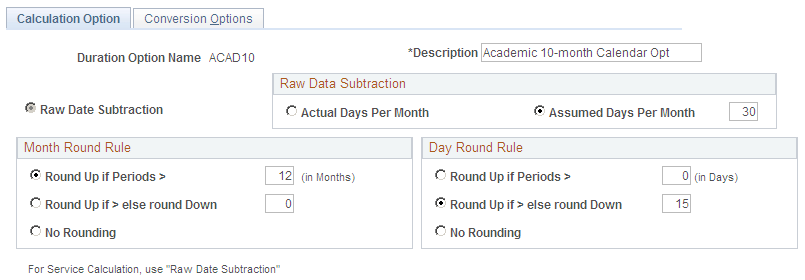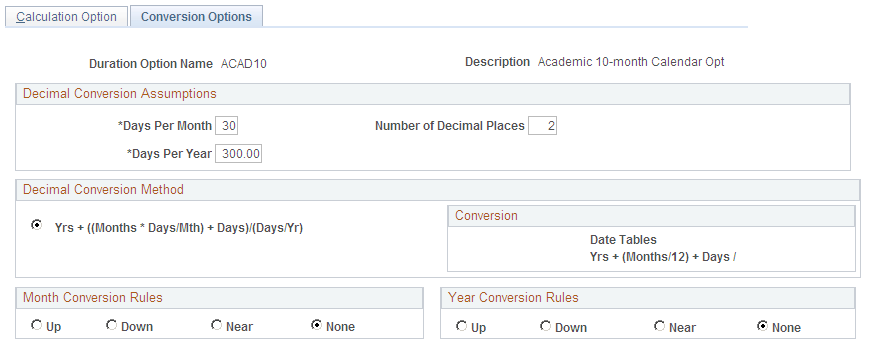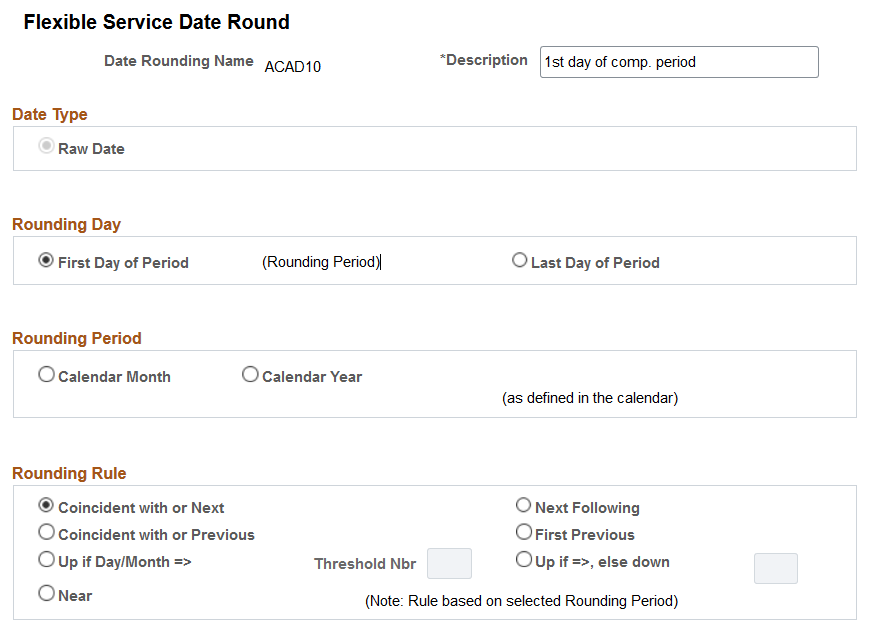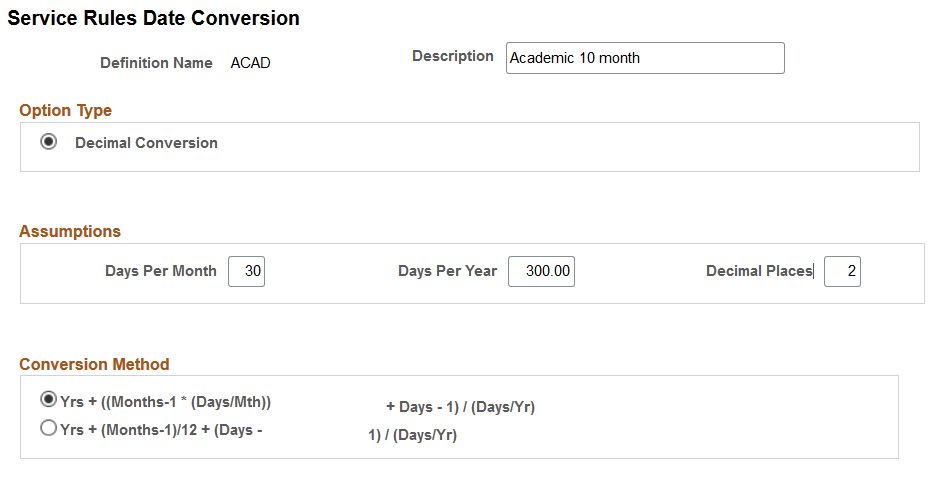Setting Up Service Parameters
To set up service parameters, use the Flexible Service Duration (EG_DURATION_OPTS), Flexible Service Date Round (EG_DATE_ROUNDING), Service Rules Date Conversion (EG_DATE_CONVERSION), Flexible Service DB Alias (EG_DB_ALIAS), and Flexible Service Trace Setting (EG_APPLICATN_TRACE) components.
|
Page Name |
Definition Name |
Usage |
|---|---|---|
|
EG_AGECALC_PERIOD |
Select a calculation method and set the parameters that are associated with that method. |
|
|
EG_AGECALC_PARMS |
Select a method for converting raw dates to decimal dates. The flexible service and tenure service processes use the conversion method after performing the subtraction. |
|
|
EG_DATE_ROUND |
Set up date rounding rules. |
|
|
EG_DATE_CONV |
Set up a date conversion method. |
|
|
EG_ALIAS_ENTRY |
Set up an event date alias for referencing the Effective Date field on the Job table. |
|
|
EG_AUDIT_PNL |
Turn on the application trace to provide a way to audit an application. |
Use the Calculation Option page (EG_AGECALC_PERIOD) to select a calculation method and set the parameters that are associated with that method.
Navigation:
This example illustrates the fields and controls on the Calculation Option page.

Field or Control |
Description |
|---|---|
Raw Date Subtraction |
This option is selected by default. |
Actual Days Per Month |
Select to have the system calculate duration using actual days in each month. |
Assumed Days Per Month |
Select to have the system assume that there are a certain number of days in each month. Enter the assumed number of days in the field next to this option. Note: Select Assumed Days Per Month to avoid possible rounding issues. |
Month Round Rule
Field or Control |
Description |
|---|---|
Round Up if Periods > (in Months) |
Select to round up when the period is greater than the number of months that you specify. |
Round Up if Periods > Else Round Down |
Select to round up when the period is greater than the number of months that you specify and round down when the period is equal to or less than the number of months that you specify. |
None |
Select to avoid rounding. |
Day Round Rule
Field or Control |
Description |
|---|---|
Round Up if Periods > (in Days) |
Select to round up when the period is greater than the number of days that you specify. |
Round Up if Periods > Else Round Down |
Select to round up when the period is greater than the number of days that you specify and round down when it is equal to or less than the number of days that you specify. |
None |
Select to avoid rounding. |
Use the Conversion Options page (EG_AGECALC_PARMS) to select a method for converting raw dates to decimal dates.
The flexible service and tenure service processes use the conversion method after performing the subtraction.
Navigation:
This example illustrates the fields and controls on the Conversion Options page.

Decimal Conversion Assumptions
Field or Control |
Description |
|---|---|
Days Per Month |
Enter the number of days per month that you want the system to assume in converting raw dates to decimals. |
Days Per Year |
Enter the number of days per year that you want the system to assume in converting raw dates to decimals. |
Number of Decimal Places |
Specify a number of places to round decimals for all points in the conversion process. Note: The number of decimal spaces that you specify here is used for the internal conversion from raw date to decimal date in the background calculation process. The final service amount that is calculated for each computational period in the tenure and flexible service calculation processes is rounded to two decimal places. |
Decimal Conversion Method
The system supports one decimal conversion formula:
The months times days divided by the month, then add the year and days. This value is divided by the product of days divided by the years.

The formula converts the months to days, adds this to the remaining days, and then converts the total days to years to calculate the decimal portion of the duration. This is then added to the years to find the total duration.
In this case, you have to specify the value in the assumed Days Per Month and the assumed Days Per Year fields.
Month Conversion Rules
Field or Control |
Description |
|---|---|
Up, Down, Near, or None |
Select one as the rule for converting months. |
Year Conversion Rules
Field or Control |
Description |
|---|---|
Up, Down, Near, or None |
Select one as the rule for converting years. |
Use the Flexible Service Date Round page (EG_DATE_ROUND) to set up date rounding rules.
Navigation:
This example illustrates the fields and controls on the Flexible Service Date Round page.

Date Type
Raw Date is the default for calculating tenure and flexible service.
Rounding Day
Select whether to round to the first day of the period or the last day of the period.
When you round to the last day of the period, you don't have to specify your rounding rule. The date is always rounded to the last day of the current period. For example, if you round to the last day of the calendar month, August 3, 2001 becomes August 31, 2001.
However, if you round to the first day of a period, you can round to the next, the coincident (with) or next, the previous, the coincident (with) or previous, or the near (nearest) rounding day.
Rounding Period
Select Calendar Month or Calendar Year. For example, when managing job history records in tenure service and flexible service calculation, select Calendar Month.
Rounding Rule
Make your rounding dependent upon a threshold number of days in the month or a threshold number of months in the year by selecting Up if Day/Month => (up if day or month is equal to or greater than) or Up if Day/Month => Else Down. Both options round up after a threshold number of days (if the rounding period is months) or months (if the rounding period is year). However, the first option doesn't round dates that are below the threshold, whereas the second option rounds down.
These tables illustrate how each of these options works. In all cases, assume that you are rounding to the first of the month.
|
Rounding Rule |
Base Date |
Rounded Date |
|---|---|---|
|
Coincident (with) or Next Following |
05/01/2005 |
05/01/2005 |
|
Coincident (with) or Next Following |
05/02/2005 |
06/01/2005 |
|
Next Following |
05/01/2005 |
06/01/2005 |
|
Coincident (with) or First Previous |
05/01/2005 |
05/01/2005 |
|
First Previous |
05/01/2005 |
04/01/2005 |
|
First Previous |
05/02/2005 |
05/02/2005 |
|
Near |
05/03/2005 |
05/01/2005 |
|
Threshold Rounding Rule |
Base Date |
Threshold |
Rounded Date |
|---|---|---|---|
|
Round Up if . . . |
05/17/2005 |
15 |
06/01/2005 |
|
Round Up if . . . Else Down |
05/17/2005 |
15 |
06/01/2005 |
|
Round Up if . . . |
05/17/2005 |
20 |
05/17/2005 |
|
Round Up if . . . Else Round Down |
05/17/2005 |
20 |
05/01/2005 |
Select a rounding rule from the following options:
Coincident or Next
Next
Coincident or Previous
Previous
Up if Day/Month =>
Up if Day/Month => Else Down
Near
Note: If you selected Last Day of Period in the Rounding Day group box, the Rounding Rule group box is unavailable for entry.
Use the Service Rules Date Conversion page (EG_DATE_CONV) to set up a date conversion method.
Navigation:
This example illustrates the fields and controls on the Service Rules Date Conversion page.

Note: This conversion option is required only for calculating flexible service. It isn't available for tenure.
Option Type
Decimal Conversion is the default.
Assumptions
Field or Control |
Description |
|---|---|
Days Per Month |
Enter the number of days per month that you want the system to assume when performing conversions. |
Days Per Year |
Enter the number of days per year that you want the system to assume when performing conversions. |
Decimal Places |
Enter the number of decimal places that you want the system to use in the final decimal figure. |
Conversion Method
Select one of the two formula methods:
The days divided by the month then multiplied by one. This is subtracted from the months, then add the days minus ones. Then add the years. This value is divided by the product of days divided by the years.

The months minus one then add the years. This value is divided by the of days minus one. Then this value is divided by the product of days divided by the years.

Use the Flexible Service DB Alias page (EG_ALIAS_ENTRY) to set up an event date alias for referencing the Effective Date field on the Job table.
Navigation:
This example illustrates the fields and controls on the Flexible Service DB Alias page.

Field or Control |
Description |
|---|---|
Database Alias Name |
Enter a field value to create a database alias for referencing the Effective Date field on the Job Table. |
PeopleSoft Table |
Select this check box to create the table in PeopleSoft format. |
Record (Table) Name |
Enter the PeopleSoft record that contains the field you want to use. |
Field Name |
Enter the field name (must be a field present on the Record Name) |
Table Key |
Enter the code for the table key. |
Use the Flexible Service Trace Setting page (EG_AUDIT_PNL) to turn on the application trace to provide a way to audit an application.
Navigation:
This example illustrates the fields and controls on the Flexible Service Trace Setting page.

Setting the application trace is useful during the implementation phase of the tenure and flexible service calculation process. Don't turn on the trace if you run the calculation on a regular basis. The application trace writes to the Service Audit table (EG_AUDIT_TRACE) and stores the internal calculation details during a calculation run.
Field or Control |
Description |
|---|---|
Produce Application Trace |
Select to turn on the application trace. |
Trace Tenure Service Calc (trace tenure service calculations) |
Select to trace tenure service calculations. |
Trace Flexible Service Calc (track flexible service calculations) |
Select to trace flexible service calculations. |